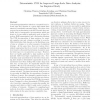Free Online Productivity Tools
i2Speak
i2Symbol
i2OCR
iTex2Img
iWeb2Print
iWeb2Shot
i2Type
iPdf2Split
iPdf2Merge
i2Bopomofo
i2Arabic
i2Style
i2Image
i2PDF
iLatex2Rtf
Sci2ools
SDM
2012
SIAM
2012
SIAM
Deterministic CUR for Improved Large-Scale Data Analysis: An Empirical Study
Low-rank approximations which are computed from selected rows and columns of a given data matrix have attracted considerable attention lately. They have been proposed as an alternative to the SVD because they naturally lead to interpretable decompositions which was shown to be successful in application such as fraud detection, fMRI segmentation, and collaborative filtering. The CUR decomposition of large matrices, for example, samples rows and columns according to a probability distribution that depends on the Euclidean norm of rows or columns or on other measures of statistical leverage. At the same time, there are various deterministic approaches that do not resort to sampling and were found to often yield factorization of superior quality with respect to reconstruction accuracy. However, these are hardly applicable to large matrices as they typically suffer from high computational costs. Consequently, many practitioners in the field of data mining have abandon deterministic appr...
| Added | 29 Sep 2012 |
| Updated | 29 Sep 2012 |
| Type | Journal |
| Year | 2012 |
| Where | SDM |
| Authors | Christian Thurau, Kristian Kersting, Christian Bauckhage |
Comments (0)

